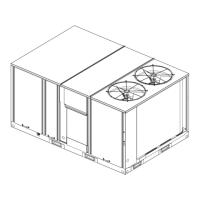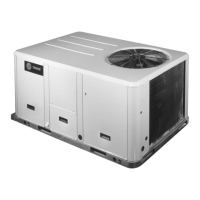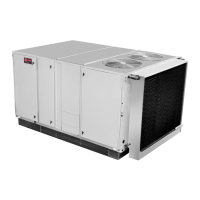Sequence of Operation
RT-SVX25Q-EN 49
MWU and DWU setpoints come from the higher
priority LCI-R DAC.
Table 14. Variable air volume mode operation
System Mode Fan “Auto” Fan “On”
Heat
DWU Active
DWU Off
DWU
2
Off
4
DWU
2
VAV Heating
4
Cool VAV Cooling
1
VAV Cooling
1
Auto
DWU Active
DWU Off
DWU or
Cooling
1,2,3,4
VAV Cooling
1
DWU or
Cooling
1,2,3,4
VAV Cooling or
Heating
1
Off Off
4
Off
4
Notes:
1. If Cooling is selected the supply fan will run continuously. If VAV
Hea
ting is activated the supply fan will run continuously.
2. I
f Daytime Warmup is Activated, the supply fan will run
contin
uously.
3. Aut
o changeover between Cooling and Daytime
Warmup dep
ends upon the DWU initiate setpoint.
4. The
fan will be Off any time the system selection switch
is
“Off”.
Supply Duct Static Pressure Control
The supply duct static pressure is measured by a
transducer with a 0.25 to 2.125 Vdc proportional output
which corresponds to an adjustable supply duct static
pressure of 0.3" w.c. to 2.5" w.c. respectively with a
deadband adjustment range from 0.2" w.c. to 1.0" w.c. The
setpoint is adjustable on the RTAM Static Pressure
Setpoint potentiometer or through ICS.
Example:
Supply Duct Static setpoint = 2.0" w.c. (RTAM)
Deadband = 0.2" w.c. (RTAM)
Duct Static Control Range = 1
.9" w.c. to 2.1" w.c.
Mechanical Cooling with an Economizer
The economizer is utilized to control the zone temperature
when the outside air conditions are suitable. The method
used to determine economizer effectiveness, depending
on the available data, is described below in descending
order of complexity.
Table 15. Economizer effectiveness
Method used to determine
economizer effectiveness Required
Comparative Enthalpy OAT, OAH, RAT, RAH
Reference Enthalpy OAT, OAH
Reference Dry Bulb OAT
Unable to determine effectiveness
OAT data is invalid or
una
vailab
le
The most sophisticated method available is always used.
Two of the three methods for determining the suitability of
the outside air can be selected utilizing the potentiometer
on the Economizer Actuator, as described below:
1. Ambient Temperature - controlling the economizing
cycle by s
ensing the outside
air dry bulb temperature.
Table 16 lists the selectable dry bulb values by
potentiometer setting.
2. Reference Enthalpy - controlling the economizer cycle
by sensing the ou
tdoor air humidity. Table 16 lists the
selectable enthalpy values by potentiometer setting. If
the outside air enthalpy value is less than the selected
value, the economizer is allowed to operate.
Table 16. Economizer configuration
Selection Dry Bulb Enthalpy Value
A 73°F 27 BTU/LB Air
B 70°F 25 BTU/LB Air
C 67°F 23 BTU/LB Air
D 63°F 22 BTU/LB Air
E 55°F 19 BTU/LB Air
3. Comparative Enthalpy - By utilizing a humidity sensor
and a temperature sensor in both the return air stream
and the outdoor air stream, the economizer will be able
to establish which conditions are best suited for
maintaining the zone temperature, i.e., indoor
conditions or outdoor conditions.
Off Mode
This mode is set at the zone sensor or by ICS. During this
status, no heating, ventilation, or mechanical cooling is
being performed. When switching the “System” selector
to the “Off” mode from any other mode, any diagnostic
data and diagnostic indication signal will be retained as
long as the system remains in the “Off” status. Switching
the “System” selector from the “Off” mode back to any
other mode of operation will reset all diagnostics.
Heating Operation
Heating operation on units configured with Traditional
Multi-Zone VAV control will utilize two separate control
methodologies based on heating configurations. For all
“Staged” Heating types, the unit will utilize 100% full
airflow during all active heating periods like traditional
Constant Volume units. If the unit has modulating heat, the
unit can be made to do discharge heating with VAV control.
This is done by placing by placing a contact closure across
the “Changeover Input” on the RTAM. During this mode,
the unit will heat to the Supply Air Heating Setpoint ± 3.5°F.
During low load or low airflow conditions the actual
temperature swing of the discharge air will likely be
greater.
Zone Temperature - Unoccupied Heating
While a building is in an unoccupied period as designated
by a remote panel with night setback or ICS, the necessary
heating capacity will be controlled to maintain the zone
temperature to within the unoccupied setpoint deadband.
For traditional VAV systems, the VFD will operate at 100%
during this mode. It will be necessary to drive VAV boxes
to their maximum position through ICS programming or
the factory provided VHR relay. For all Staged Heating

